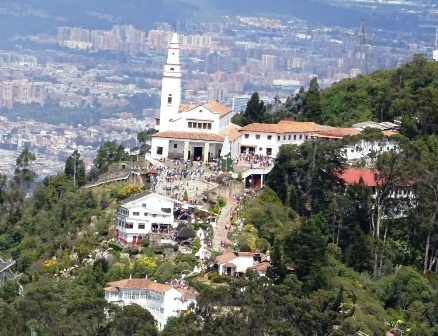
Click the photo above to see a Bogota album. Close the window to return.
Read Next Episode: Cartagena
Bogota, at 2625m (8600 ft), is the capital of Colombia and has 7.4 million people spread over a wide area hemmed in by mountains. It is a big city and at such a high altitude, is a lot colder than the tropical Yucatan we had just left. We arrived in mid-day to sunny, warm 20C weather, but after 4:30 PM, when the sun started to go down the temperature dropped to a low of 8C overnight. We had come prepared with long pants, a fleece and a rain jacket to provide at least three layers. The other acclimatization we coped with was the difficulty of climbing the steep street to our hostel in La Candelaria, the old Colonial section of town. All of sudden we were walking much slower than usual and even stopping to catch our breath. I think we were getting used to the altitude and climate before we left a few days later.
There were benefits to staying in the Candelaria. All the best sites were a short walk away and there was no shortage of restaurants. We visited the Plaza de Bolivar, a huge square in front of the Cathedral and surrounded with important government building. All the tourists, both local and foreign end up at this square, buying corn to feed the pigeons and watching children ride the llamas waiting for customers.
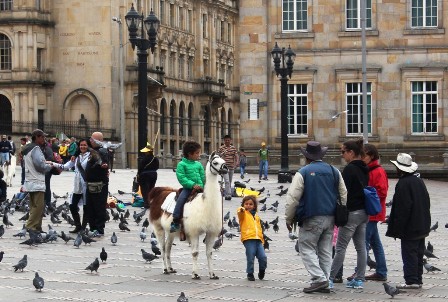 ride a llama in Plaza de Bolivar |
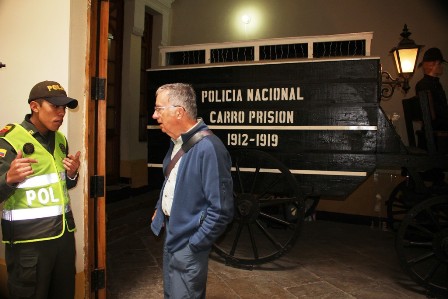 the young police trainee was our guide in the museum |
We were approached by a young policeman, who asked us where we from and asked if we would like to tour the National Police Museum. It didn’t sound like our first choice of activites so we refused and continued walking the streets admiring the beautiful, well restored buildings. I was reading the Lonely Planet as we walked and was surprised to read that the Police Museum was more than I had thought. We sought out the young man who had approached us and told him we had changed our mind. He took us to the Museum, housed in the original headquarters of the National Police, where we waited for another guide to show us around the museum. Our guide, Jonathan, explained that all 18 year old boys in Colombia are required to spend one year in the National Police force. Those who are interested, train to be a guide in the museum. Jonathan considered being a guide a lot safer and more interesting than standing guard at a building or street corner. The job also gave him the opportunity to practise his English skills. The tour was interesting. It had examples of old transport vehicles, including a paddy wagon that picked up people found guilty of minor infractions and kept them in the wagon, in full view of the population for one day. Nowadays they would be fined, but public humiliation was the punishment then. There were also displays highlighting the different roles played by the police, including social service. The biggest draw for most visitors was the role played by the police in apprehending and controlling the drug trade, whose most infamous member was Pablo Escobar. How many of you have watched the TV miniseries, now on Netflix, Narcos. We watched it before we left home and are glad it is no longer as violent as it once was.
The afternoon after we visited Guadalupe hill, we joined
the immensely popular Graffiti walking tour. About 30 tourists followed the very
knowledgeable Jay, who was born in Colombia and Raised in New York and Florida.
We spent 2 ½ hours walking the streets of Candalaria and into some of the
business area admiring the art work covering almost every wall space, both on
public and private spaces. The tour was originated by Crisp, the tag name of one
of the artists, a few years ago. The graffiti artists and they are artists, like
to think they have won the battle to keep on painting without being arrested.
About a year or two ago the city invited artists to paint the walls of a new
super highway leading to the airport. They had expected just a few artists to
show up and were astounded when 400 showed up. I was certainly impressed by the
works. Bogota now draws artists from all over the world and is counted one of
the 10 best cities to view graffiti art.
Click the photo above to see a Graffiti Tour album. Close the window to return.
The Botero Museum, featuring works by Fernando Botero, Colombia’s most famous artist is on everyone’s list, ours included. Botero specializes in depicting decidedly chubby people, often in poses poking fun at famous works of art. There was also a smaller collection of works by the world’s top masters including Picasa, Juan Miro and others.
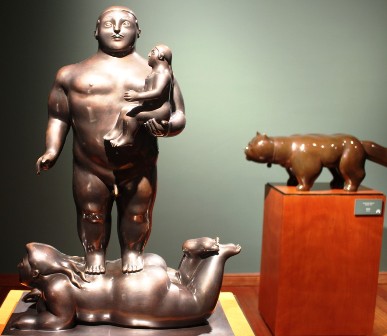 Botero's chubby family |
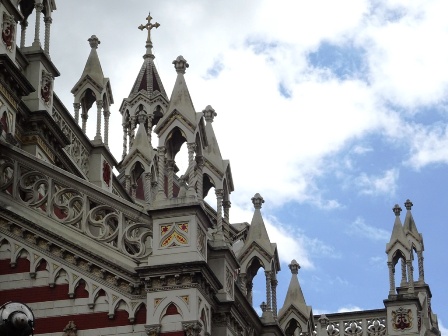 San Agustin Church towers |
|
Return to Columbia Intro
Return to Travels
Return to Introduction